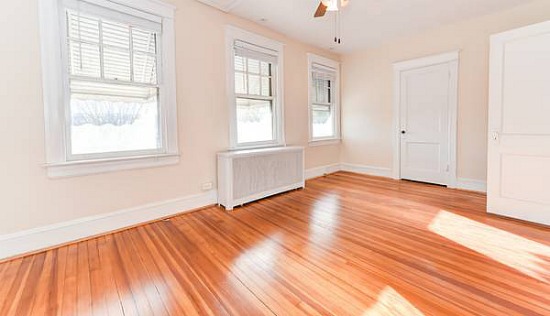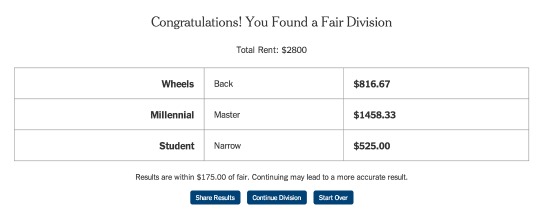 Is This the Fairest Way to Split the Rent?
Is This the Fairest Way to Split the Rent?
✉️ Want to forward this article? Click here.

A mathematical theorem called Sperner’s Lemma could hold the key to living in harmony with roommates, at least when it comes to dividing the rent fairly, according to The New York Times.
Rentals can be difficult to split up among roommates, especially in older units where room size isn’t uniform and each may have different access to natural light. In DC, splitting a rowhouse with roommates may mean one person lives in an English basement room while another enjoys a spacious master bedroom, the rent divided up as fairly as possible. Sperner’s Lemma suggests that because each roommate has different priorities when it comes to space and pricing, there’s a happy medium at which each person is content with their chosen room and the price point at which they’ll be renting it. This creates the ideal “envy-free” living situation where no roommate is jealous of another roommate’s perceived superior deal.
The lemma calculates the price points at which every roommate finds their happy place. The method describes a triangle with three points: Point A, Point B, and Point C. The interior of the triangle is further divided to represent the variety of ways that rent could be split. When using the method to calculate rent, each interior triangle corresponds to a different split, where A pays x, B pays y and C pays z. The rent can be more accurately and “fairly” divided the more the triangle is divided. The more mathematically-minded can read about the theorem in depth here.
A New York Times tool used to split the rent incorporates the theorem into its calculations. It works by changing the division of prices from room to room until everyone ends up at a price point and room they’re happy with.
Before using the tool, the creators advise making sure it’s necessary. They note that the tool won’t work if one person doesn’t want any of the rooms, or if one roommate would always take the most expensive room even if rent is free on another room.
UrbanTurf looked at a recent rental listing on Craigslist and used Sperner’s Lemma to calculate who might pay what given a hypothetical set of roommates.
The house in Petworth is offered at $2,800/month.
Here are our hypothetical roommates:
Roommate A, “Wheels”: Has a car and a decently paid job. Can’t pay more than $1,300/month.
Roommate B, “Millennial”: Bikes to work and makes a tidy sum. Can’t pay more than $1,800/month.
Roommate C, “Student”: A grad student who works nights to bring in extra income. Can’t pay more than $1,000/month.
And the rooms:
Master Room: The traditional master bedroom with three bright windows bringing in lots of natural light.
Narrow Room: A narrow bedroom with an interior window, meaning less privacy.
Back Room: A big bedroom with just one window near the back of the house. It’s quieter during the day.
The roommates decide ahead of time that the parking spot is worth about $100 a month, a little below market price since they know just one of them needs it. As a result, Wheels reduces her top price to $1,200/month. Going into negotiations, Wheels wants the master, and so does Millennial, while Student wants the back room because it’s the most quiet in the morning.
Using the tool with our hypothetical roommates in mind, UrbanTurf made decisions we thought made sense for each roommate and ended up with this:

Wheels pays $816 for the back room, because with the cost of the parking pad she couldn’t compete with Millennial’s ability to pay for the room she most wanted (even without factoring in parking, it still wasn’t in her budget). Millennial got the room she wanted for $1,458 a month because she had the most money to work with. And Student ended up with the cheapest room, which she didn’t really want — but she loves the price at $525. At the end of the day, everybody feels like they got a good deal on their room.
Check out the NYT’s tool here and see whether you can live in an envy-free rent situation in DC.
See other articles related to: sperners lemma, splitting the rent
This article originally published at https://dc.urbanturf.com/articles/blog/a_fair_way_to_split_the_rent_one_formula_may_crack_the_code/8418.
Most Popular... This Week • Last 30 Days • Ever

UrbanTurf takes a look at the options DC homeowners and residents have to take advant... read »

A major new residential development is on the boards for a series of properties near ... read »

A new report from DC’s Office of Revenue Analysis highlights how millennials and wo... read »

The building is the second proposal for a pair of aging office buildings in downtown ... read »

The central action before the Board is a rezoning request for the nearly 36-acre site... read »
- A Solar Panel Primer for DC Residents
- 29-Story, 420-Unit Development Pitched For Middle Of Downtown Bethesda
- How DC's Population Changed During And After The Pandemic
- Fitting In: A Narrow 260-Unit Apartment Building Pitched For Bethesda
- Arlington County To Weigh Major Actions Advancing RiverHouse Redevelopment
DC Real Estate Guides
Short guides to navigating the DC-area real estate market
We've collected all our helpful guides for buying, selling and renting in and around Washington, DC in one place. Start browsing below!
First-Timer Primers
Intro guides for first-time home buyers
Unique Spaces
Awesome and unusual real estate from across the DC Metro














